Study of the Decay B0 → ωKS0 at Belle
Veronika Chobanova
Diploma Thesis
Supervisor Prof. Dr. Allen Caldwell
December 15th 2011
Max-Planck-Institut f¨ur Teilchenphysik
Technische Universit¨at M¨unchen Department f¨ur Physik
Abstract
We present a measurement of the branching fraction of the decay channel B0 → ωK0 and the neutral B meson lifetime. These results are obtained from a data sample which contains 152×106 BB¯ pairs collected at the Υ(4S) resonance with the Belle detector at the KEKB asymmetric e+e− collider.
We obtain the branching fraction,
B(B0 →ωK0) = [4.94+1.28−1.14 (stat)]×10−6, and theB0 meson lifetime,
τB0 = [1.22±0.35 (stat)] ps, which are in agreement with the current world average.
By introducing an improved analysis technique, we also demonstrate that our method pro- vides superior statistical uncertainties over the previous Belle analyses for the branching fraction and the time-dependent CP parameters.
Eigenst¨andigkeitserkl¨arung
Die Arbeit wurde selbstst¨andig verfasst und es wurden keine anderen als die angegebenen Quellen und Hilfsmittel verwendet.
M¨unchen, den 15. Dezember 2011
...
Veronika Chobanova
Contents
1 Introduction 1
2 Theoretical Motivation 3
2.1 A Brief Introduction To The Standard Model . . . . 3
2.2 CP Violation . . . . 5
2.2.1 The C, P and T Symmetries . . . . 6
2.2.2 Neutral Kaon System . . . . 7
2.2.3 Cabibbo-Kobayashi-Maskawa (CKM) Mechanism . . . . 8
2.2.4 Unitarity Triangle . . . . 9
2.2.5 Time Evolution of Neutral Mesons . . . . 11
2.2.6 Classification ofCP Violation . . . . 14
2.3 CP Violation in the B Meson System . . . . 16
2.3.1 Time Evolution of Neutral B Mesons . . . . 16
2.3.2 Time-DependentCP Violation . . . . 17
2.3.3 CP Violation Measurement . . . . 18
2.4 The Decay Channel B0 →ωKS0 . . . . 20
2.4.1 B(B0 →ωKS0) . . . . 20
2.4.2 CP Violation in B0 →ωKS0 . . . . 21
2.4.3 Previous Measurements . . . . 22
3 The Belle Experiment 25
3.1 The KEKB Accelerator . . . . 25
3.2 The Belle Detector . . . . 26
3.2.1 The Beam Pipe . . . . 30
3.2.2 The Silicon Vertex Detector (SVD) . . . . 30
3.2.3 The Central Drift Chamber (CDC) . . . . 32
3.2.4 The Aerogel Cherenkov Counter (ACC) . . . . 34
3.2.5 The Time Of Flight Counter (TOF) . . . . 35
3.2.6 The Electromagnetic Calorimeter (ECL) . . . . 36
3.2.7 The Solenoid . . . . 36
3.2.8 KL0 and Muon Detector (KLM) . . . . 37
3.2.9 Trigger and Data Acquisition . . . . 38
4 Reconstruction of the Decay B0 →ωKS0 43 4.1 Decay Channel . . . . 43
4.2 Monte Carlo and Data Samples . . . . 44
4.3 Non-hadronic Event Suppression . . . . 45
4.4 Full Number of Events N(BB)¯ . . . . 46
4.5 Selection Criteria for the Reconstruction . . . . 47
4.5.1 General Reconstruction Method . . . . 47
4.5.2 Track and Event Selection for Pions . . . . 48
4.5.3 KS0 and ω Reconstruction . . . . 49
4.5.4 B Meson Reconstruction . . . . 50
4.5.5 B Decay Vertex Fit . . . . 52
4.5.6 Flavour Tagging . . . . 52
4.5.7 Best B Candidate . . . . 55
4.5.8 Tag-Side Vertexing . . . . 55
4.5.9 The Detector Resolution for ∆t . . . . 56
CONTENTS iii
4.6 Continuum Identification . . . . 57
4.6.1 B Flight Direction cosθB . . . . 57
4.6.2 Fox-Wolfram Moments . . . . 59
4.6.3 Fisher Discriminant . . . . 59
4.6.4 Likelihood Ratio LBB/q¯¯ q and Fisher DiscriminantFB ¯B/q¯q . . . . 62
4.7 ω Helicity . . . . 63
4.8 Reconstruction Efficiency . . . . 64
5 Branching Ratio Measurement 65 5.1 Expected Event Number in the Data Sample . . . . 65
5.2 Fit Model . . . . 66
5.2.1 The Final State Components . . . . 67
5.2.2 The Model . . . . 68
5.3 Validity Studies and Systematics . . . . 96
5.4 Fit to the Data . . . . 104
5.5 Limitations of the Result . . . . 105
6 Conclusion 109 A Chebyshev Polynomials 111 B Fit Methods 113 B.1 The Extended Maximum Likelihood Method . . . . 113
B.2 MINUIT2 . . . . 114
C Correlations for the Data Model 117
Chapter 1 Introduction
The first hint at the expansion of the Universe was given by Erwin Hubble’s measurements [1]
of the redshift of distant galaxies at the beginning of the 20th century. According to these observations, the bigger the distance to a galaxy from our point of view, the higher its apparent velocity. Theory explains this with the model of the Big Bang: The Universe originates from a single point with an infinite density and temperature and since its beginning it has been expanding and cooling down, reaching the temperature of 2.7 K nowadays.
At its early stage, the Universe was much hotter. At this time, a huge amount of particle- antiparticle pairs were created, which later on during the cooling first built the nuclei, then the atoms and eventually the bigger structures like stars and galaxies. All these consist either of massive particles or light. No objects consisting only of antiparticles were observed so far. So what happened to all the antimatter?
As at its early stage the Universe was too dense to allow a macroscopic separation of matter and antimatter, it is assumed that some asymmetry between both led to the disappearance of all the antimatter. This asymmetry should be based on violation of matter-antimatter symmetries (C, CP) as well as violation of the thermodynamic equilibrium in the early stage, as Sakharov postulated in 1976 [2]. In 1964, Cronin and Fitch observed the first CP-violating process in the neutral kaon system [3]. Later on, theCP-violating mechanism was described by Kobayashi and Maskawa for which they were awarded the Nobel Prize in 2008, and confirmed in many other experiments.
Nevertheless, the search for new CP violation sources goes on. In two so-calledB-factories, huge amounts of BB¯-pairs were produced. The Belle experiment at the KEK accelerator in Tsukuba, Japan, and the BaBar experiment at the SLAC accelarator in Stanford, USA, each produced several hundred millions ofBB¯-pairs for CP violation studies. These studies investigate the decays ofB and ¯B mesons and look for asymmetries in these two decays. In particular the time-dependent asymmetries of B and ¯B decays to CP can give us hints to possible sources of CP violation.
In this work, the measurement of the branching fraction of the rare B decay B0 →ωK0 is
presented. This decay gives access to one of the CP violating phases observed in B decays calledφ1. The dominating Feynmann diagram contributing to this decay contains a particle loop. Through this particle loop, elements from Physics beyond the Standard Model can influence the decay process. Thus, the interest in exactly measuring the phases of this decay.
We first present a brief theoretical overview in Chapter 2, followed by the description of the experimental setup in Chapter 3. The reconstruction of the B meson from the final state particles is described in Chapter 4. The methods and models used in this measurement, as well as the result obtained from the data are presented in Chapter 5.
Chapter 2
Theoretical Motivation
2.1 A Brief Introduction To The Standard Model
The Standard Model (SM) successfully describes three of the four fundamental interactions of matter: strong, weak and electromagnetic. All these interactions are carried out by bosonic mediators (Table 2.1). According to the SM, there are twelve fermionic particles that form all matter. Depending on their quatum number flavour, they are either leptons or quarks.
There are six leptons and six quarks, grouped in three families, as shown in Fig. 2.1. For each fermionic particle, a corresponding antiparticle exists. The antiparticles of the charged fermions have opposite charges but are equal in all of their quantum numbers.
The quarks are the only fermions interacting via the strong force. Besides the electromagnetic charge they also carry colour - the charge of the strong interaction. The corresponding antiparticles carry anticolour. Due to colour confinement this charge is not observed on the macroscopic level. The mediators of the strong interaction are the gluons, which also carry colour. Neutrality is achieved either when three quarks or a quark-antiquark pair are bound together. There are two kinds of hadrons depending on the number of quarks they contain.
Hadrons made by three quarks are called baryons and those made of a quark-antiquark pair mesons. As quarks carry electromagnetic charge of either +23 or −13 and antiquarks carry the opposite charge, the hadron charge is integer.
The six leptons, the electrone−, muonµ−, tauτ− and the three corresponding neutrinos, are
Interaction Strong Weak EM Gravitation
mediator gluon g W±, Z0 γ graviton(?)
range(m) 10−15 10−18 ∞ ∞
potential distance dependency αr−1+βr 1/r 1/r
relative strength 1 10−13 1/137 10−38
Table 2.1: The fundamental interactions.
Figure 2.1: The elementary particles of the SM [4].
colourless. The quarks and the charged leptons interact also via the electromagnetic force.
Its mediator particle is the photon γ, which couples to all electrically charged particles but does not carry charge itself.
The mediators of the weak interaction are three heavy bosons - W± and Z0. Their big masses (mW± = 80 GeV/c2 and mZ0 = 91 GeV/c2) limit the range of the weak force to the order of 10−18m. The weak interaction has one unique quality: Through exchange of W± (charged current), the flavour of a particle can be changed.
As the photon has no mass, the range of the electromagnetic interaction is infinite. One could think that this should be the case for the strong interaction as well but it is not, as the gluons are indeed massless but they also interact with each other which limits the range of the strong force.
Symmetries are essential in physics. In 1918, Emmy Noether published her famous Theo- rem [5] which states that any action which is invariant under a symmetry transformation leads to a corresponding conservation law and vice versa. For example, the energy and mo- mentum conservation follow from the homogeneity of space and time. Symmetries are also found in the SM which involves the internal symmetry groups SU(3) for the strong, SU(2) for the weak and U(1) for the electromagnetic interaction. The last two can be further unified to SU(2)×U(1) to the internal symmetry of the electroweak theory. In order to explain the big mass of the W andZ boson, it is required that the electroweak symmetry is spontaneously broken. This is known as the Higgs mechanism [6].
Although the SM makes many predictions which are in agreement with numerous experi- mental results, a big number of questions in physics is still open, such as,
2.2 CP Violation 5
• Can the strong and the electroweak forces be further unified to one Grand Unified Theory (GUT) as already achieved with the electromagnetic and weak interactions?
• Does the Higgs exist and if yes, what are its properties?
• What is dark matter? Various observations of astrophysics require the existence of additional matter that we do not see directly. Even less understood is dark energy which makes up∼70% of the energy in the Universe.
• Are there other particles than those in the SM? Does supersymmetry exist?
• Does nature have more than the four known space-time dimensions? If so, what is their size?
• Why are there exactly 3 lepton families and 4 fundamental interactions?
• Is the neutrino its own antiparticle?
So although the SM effectively describes the phenomena within its domain, it is nevertheless incomplete. Perhaps there is still a big amount of New Physics beyond it. Huge efforts have already been made in explaining what the SM cannot. One important issue is the asymmetry between matter and antimatter in the Universe today (CP violation). The expectations of the Standard Model concerning the range of this asymmetry are insufficient to explain the small ratio of ∼10−10 antiparticles per particle.
The search for new sources of the asymmetry between matter and antimatter is the object of theBmeson collider experiments such as Belle, BaBar and LHCb. B( ¯B) mesons contain one b anti-quark (quark) and one light quark (anti-quark). For reasons which will be explained in the next sections, these mesons are a suitable physical system for CP violation studies.
Just like other mesons, for example the kaonK and theDmeson, the bound quarks in them interact with each other via the weak force which allows one quark to change its flavour.
One particular case of this interaction where asymmetry between mesons and anti-mesons is observed is the transition between particles and antiparticles in the neutral meson systems.
This asymmetry arises from the different probabilities of particle to anti-particle transition for the neutral mesons and their anti-mesons. Another source of asymmetry are the different decay rates of a particle and its anti-particle into a certain (conjugated) final state. By measuring the difference in the decay rates of the mesons and the anti-mesons one can obtain the CP violation parameters which will also be explained in the following sections.
2.2 CP Violation
The weak interaction has one unique feature: It does not conserve the discrete symmetriesC, P andT. This means that the laws of physics change under such symmetry transformations.
In addition, in the weak interaction the CP symmetry is also broken. The meaning of this will be discussed in the following.
2.2.1 The C, P and T Symmetries
Charge conjugation Ctransforms a particle A into its antiparticle ¯A which has the same mass, momentum and spin but opposite charge,
C|Ai=|Ai.¯ (2.1)
Only right-handed antiparticles and left-handed particles participate in weak processes. In the case of massless particles such as the neutrino, this means that only right-handed an- tiparticles and left-handed particles exist. No left-handed antineutrinos or right-handed neutrinos have ever been observed. This means that by conjugating the charge of a particle its whole physics would change in a way that certain processes will not be possible. So in these processes Cis maximally violated.
Parity reversal P is a reflection at the origin,
P((t, ~x)) = (t,−~x). (2.2)
Space coordinate x, momentum p and angular momentuml=x×p transform as follows,
x−→P -x p−→P -p l−→P l. (2.3)
Obviously, not all vectors transform the same way. Polar vectors v like x and p flip their sign. Axial vectors a like l remain unchanged. This also leads to the distinction between scalars s=v·v=a·a−→P s and pseudoscalars p=v·a−→ −p.P
Until the 1950s, it was believed thatPandCare universal symmetries and therefore always conserved as it is the case for the strong and electromagnetic interactions. In 1956 though, trying to explain the θ −τ puzzle (C.F. Powell, 1949), Tsung-Dao Lee and Chen Ning Yang (Nobel prize 1957) pointed out that parity conservation had never been tested in weak decays [7]. In the same year, Chien-Shiung Wu demonstrated [8] that parity conjugation is maximally violated in weak decays and that weak interaction only couples to left-handed particles and right-handed antiparticles, which was also confirmed by the experiment of Goldhaber [9].
The combination of C and P CP, was also believed to be conserved, until in 1964, James Watson Cronin and Val Logsdon Fitch showed in their experiment with neutral kaons that it also is broken [3]. This result brought them the Nobel prize in 1980. The effect is rather small compared to the violations in each symmetry alone but still significant enough.
Time conjugation T reflects the time t to −t and has no effect on the space coordinates x,
T((t, ~x)) = (−t, ~x), (2.4)
2.2 CP Violation 7
s
¯ s
u,c,t W−
d d¯
¯ u,¯c,¯t
W+
K0 K¯0
s
¯ s
W+ u,c,t
d d¯
W−
u,c,t
K0 K¯0
Figure 2.2: Leading Feynman diagrams contributing to Kaon-oscillation
and thus represents the reversal of motion in time,
x−→T x p −→T -p l−→T -l. (2.5)
In the framework of Lagrangian field theory it can be proven that any local and Lorentz- covariant quantum field theory is invariant under theCP T operation, which is a combination of C, P and T. This statement is also known as the CP T theorem [10]. This means that if CP is violated, T also has to be violated in order to conserveCP T.
2.2.2 Neutral Kaon System
As already mentioned, CP violation was observed for the first time in the neutral kaon system. Kaons are a group of mesons which consist of a strange quark and a light up or down quark. They are produced via the strong interaction but decay weakly, dominantly into two or three pions. The decay into two pions has an even CP eigenstate and the decay into three pions an odd one. Decays of both K0 and its antiparticle ¯K0 to the same final CP eigenstate have been measured. This is an hint at the existence of a transition between K0 and ¯K0. This process is of second order in the weak interaction and is called flavour mixing. The two leading Feynman diagrams contributing to the kaon oscillation are shown in Fig. 2.2. K0 and ¯K0 are noCP eigenstates. |K1iand |K2iare the eigenstates of the CP operator,
CP|K1i= +|K1i and CP|K2i=−|K2i. (2.6) They are linear combinations of the physical states |K0i and |K¯0i, given by,
|K1i=p|K0i+q|K¯0i (2.7)
|K2i=p|K0i −q|K¯0i (2.8)
with p
p2+q2 = 1. In the caseCP is conserved, p=q= √1
2.
|K1i corresponds to a decay into (ππ) and |K2i to a decay into (πππ). K0 has a mass of 498 MeV and the lighter pion almost 140 MeV [11]. This is why the phase space of the (πππ)
decay is much smaller than the phase space of the (ππ) decay. Therefore, the decay into three pions is strongly suppressed and the lifetime ofK2 is 600 times larger than the lifetime of K1. This fact was used in the experiment by J. Cronin and V. Fitch [3] in which they studied coherentK1 regeneration in a beam of neutral kaons. The beam line was chosen to contain all the short living K1’s. Only the long living K2’s were supposed to reach its end.
Instead, a small fraction of decays into two pions was observed, Γ(K2 →ππ)
Γ(K2 → all) = (2.0±0.4)×10−3. (2.9) The firstCP violating process was discovered. The short and long living states were identified as mixtures of the CP eigenstates and were called KS0 and KL0 respectively,
|KS0i= 1
√1 +2(|K1i+|K2i) |KL0i= 1
√1 +2(|K2i+|K1i), (2.10) with the small admixture parameter|| ∼2×10−3.
2.2.3 Cabibbo-Kobayashi-Maskawa (CKM) Mechanism
The weak eigenstates of the quarks are linear combinations of their mass eigenstates. This was first postulated by Nicola Cabibbo in 1963 to explain flavour transitions in the charged weak interaction. The relation between the weak eigenstates and the mass eigenstates can be described in matrix formalism. The matrix elements Vij represent the transition probability amplitude between two quark flavours. For this, a unitary matrix is needed in order to conserve the probability. This matrix can be formulated as a rotation by the Cabibbo angle θC. Experiments have shown that θC = 13.04◦ [12],
d0 s0
weak
=
cosθC sinθC
−sinθC cosθC
d s
mass
. (2.11)
As this formalism was first introduced, only the lightest quarks u, d, s were known. As later the third quark generation was found, a unitary 3×3 matrix was needed to explain the mixing between the three generations. A unitary, complex n×n matrix contains n2 free parameters. The quark fields have an arbitrary phase which can be rotated freely and absorbed in a phase convention: Vij → ei(φ(j)−φ(i))Vij. This removes 2n−1 free parameters and n2 −2n + 1 = (n−1)2 independent parameters are left. They can be translated to n(n−1)/2 rotation angles and (n−1)(n−2)/2 complex phases where at least one phase is needed for describing CP violation. The case of two quark generations with n = 2 gives (as in 2.11) only one angle and no phase. n = 3 gives 3 angles θi, and one phase δ and hence is the first representation of quark mixing matrices that allows CP violation. This is how Kobayashi and Maskawa (Nobel prize 2008), extending Cabibbo’s model, predicted a third quark generation before the c, b and t quarks were discovered. The CKM mechanism
2.2 CP Violation 9
is represented by a 3×3 matrix,
d0 s0 b0
weak
=VCKM
d s b
mass
≡
Vud Vus Vub Vcd Vcs Vcb Vtd Vts Vtb
d s b
mass
, (2.12)
where the matrix elementsVij represent the transition probability amplitude of a quark with flavour j becoming a quark with flavour i, and have to be obtained experimentally. This matrix has four degrees of freedom: three Euler angles θ12, θ23 and θ31 of rotation in quark flavour space and a CP violating phase δ. The parametrisation chosen by Kobayashi and Maskawa is given by [11],
VCKM =
c1 −s1c3 −s1s3
s1c2 c1c2c3−s2s3eiδ c1c2s3+s2c3eiδ s1s2 c1s2c3+c2s3eiδ c1s2s3 −c2c3eiδ
, (2.13)
wheresi(ci) means sinθi(cosθi) fori= 1,2,3. The angleθ12 is identical to the Cabibbo angle θC. The structure of CP violation can be better understood in the Wolfenstein representa- tion [13], which expands the CKM-Matrix in orders of λ = sinθC ≈ 0.2257 and is written in terms of three other parameters A, ρ and η with 0< A, ρ, η <1. This parametrization is unitary in all orders of λ [11],
CCKM =
1−λ2/2 λ Aλ3(ρ−iη)
−λ 1−λ2/2 Aλ2 Aλ3(1−ρ−iη) −Aλ2 1
+O(λ4). (2.14)
As it is obvious from the Wolfenstein representation, the diagonal elements are close to one whereas the remaining elements are smaller. Those which represent a transition over two generations are the smallest and close to zero.
2.2.4 Unitarity Triangle
As the CKM matrix VCKM is unitary, VCKMVCKM† =1 and the products of each two lines or two columns equals 0. For example, for two columns the following relation is valid,
X
k
VkiVkj∗ = 0. (2.15)
These relations can be expressed geometrically by triangles in the complex plane, so called unitarity triangles. As the length of the sides of these triangles correspond to the product of two elements of the CKM matrix, they can be obtained from measuring proper decay rates.
There are three relations which apply to B mesons. These are the three products between columns, including the last column of the matrix, which contains all the b quark transition
elements. A particularly important relation is the product of the first and third column of the matrix,
VudVub∗ + VcdVcb∗ + VtdVtb∗ = 0.
O(λ3) O(λ3) O(λ3) (2.16)
In the case of Eq. 2.16, the sides are of similar size inλ, so that all the angles of this triangle also have to be of the same order. This makesB mesons a perfect system to test the CKM formalism.
These angles can be determined by measuring the asymmetries between particles and an- tiparticles in their transitions to a certain final state. The strength ofCP violation is reflected in the area, which is the same for all triangles, since the internal angles correspond to the complex phase. In case it is zero (ornπ), the representation in the complex plane is reduced to the real axis and hence the area is also zero. It can be shown [14] that the area is given by,
ACKM= 1
2J, (2.17)
with the measure of CP violation,
J =|=(Vkm∗ VlmVknVln∗)|=|=(Vmk∗ VmlVnkVnl∗)| ≈A2λ6η. (2.18) It is convenient to normalize the triangle from Eq. 2.16 by |VcdVcb∗|. This fixes this one side from (0,0) to (1,0) in the complex space (Fig. 2.16).
0
η ρ,
( )
(1,0)
Φ
Φ
3 Φ1
V V 2
V Vcd cb*
V V V Vcd cb*
ud ub* *
tb td
Figure 2.3: The unitary triangle corresponding to Eq. 2.16.
The coordinates of the top corner (ρ, η) and the angles (φ1, φ2, φ3) of the rescaled triangle are given by,
ρ≡
1− λ22
ρ η≡
1− λ22
η (2.19)
φ1 ≡arg
−VVcdVcb∗
tdVtb∗
φ2 ≡arg
−VVtdVtb∗
udVub∗
φ3 ≡arg
−VVudVub∗
cdVcb∗
. (2.20)
2.2 CP Violation 11
Measuring the decay of particular modes then contributes to the measurement of correspond- ing sides or angles of such a triangle. In case unitarity ofVCKM is fulfilled, meaning the SM’s description of CP violation is correct and complete, then the triangle closes. Otherwise, deviations from unitarity would be a hint for New Physics. Since for defining a triangle it is sufficient to fix the value of either two sides and an angle between them or two angles and one side or three sides, this problem is over-constrained from the experimental point of view as there are two sides and three angles, which can be measured. The results combined from many measurements [15] are shown in Fig. 2.4. So far, they are well in agreement with the SM, but as the statistical uncertainties are big, there is still room for New Physics.
Therefore, high precision measurements with very high statistics are needed.
φ3
φ2
φ2
md
∆
εK
εK
ms
& ∆ md
∆
Vub
φ1
sin 2
(excl. at CL > 0.95) < 0 φ1 sol. w/ cos 2
φ2
φ1
φ3
ρ
-0.4 -0.2 0.0 0.2 0.4 0.6 0.8 1.0
η
0.0 0.1 0.2 0.3 0.4 0.5 0.6 0.7
excluded area has CL > 0.95
Summer 11
CKM
f i t t e r
Figure 2.4: The current constraints on the CKM triangle.
2.2.5 Time Evolution of Neutral Mesons
As already discussed in Section 2.2.2, neutral mesons (called P0 in this section) like the neutral kaon can couple to their antiparticle and form mixed states. The wave function of the particle is as a linear combination of the time-dependent wave functions|P0iand|P¯0iof the meson and the anti-meson respectively. In the Weisskopf-Wigner approximation[14][16], the time evolution of such a state is given by,
|ψ(t)i˜ =|P0(t)i+|P¯0(t)i=a(t)|P0i+b(t)|P¯0i, (2.21) where |P0i and |P¯0i are the eigenstates of the neutral mesons and a(t) and b(t) are time- dependent parameters. The time dependent Schr¨odinger equation can then be written as
i~∂
∂tψ(t) = Hψ(t), (2.22)
where ψ(t) is represented in terms of the time-dependent parameters from Eq. 2.21, ψ(t) =
a(t) b(t)
, (2.23)
and H is the decomposed effective Hamiltonian, H=Hij =M− i
2Γ=Mij − i
2Γij. (2.24)
This matrix is not hermitian, otherwise the mesons would only oscillate but not decay[17].
M is a 2×2 mass matrix and Γ a 2×2 decay matrix. Both M and Γ are hermitian and therefore they satisfy
Mij =Mji∗ and Γij = Γ∗ji. (2.25) The off-diagonal elements of H represent flavour changing transitions P0 ↔ P¯0, and the diagonal elements represent flavour conserving P0 ↔ P0 transitions. If CP is conserved, then H12 = H21∗ . In case we assume CP T invariance, the diagonal elements have to be equal: H =H11 =H22 and H =M −2iΓ [18] with
M11=M22≡M and Γ11 = Γ22 ≡Γ. (2.26) Inserting Eq. 2.25 and 2.26 into 2.24, provides
H =M− i 2Γ=
M− 2iΓ M12− 2iΓ12 M12∗ −2iΓ∗12 M − 2iΓ
. (2.27)
The eigenvalues are obtained by diagonalizing the matrix, µ1,2 =M − i
2Γ± s
M12− i 2Γ12
M12∗ − i 2Γ∗12
. (2.28)
The corresponding eigenstates are
|P1i=p|P0i+q|P¯0i for µ1 (2.29)
|P2i=p|P0i −q|P¯0i for µ2. (2.30) The ratio between p and q is
p q =
sM12∗ − 2iΓ∗12
M12− 2iΓ12 ≡ 1−
1 +, (2.31)
2.2 CP Violation 13
with p= √1+
2(1+2) and q= √1−
2(1+2) and the normalization p
p2+q2 = 1.
In the case ofCP invariance, the probability of one flavour being transformed into the other flavour is the same for both the neutral meson and its anti-meson. This means then that M12=M12∗ and Γ12 = Γ∗12 and therefore= 0 andp=q. Those eigenstates, which represent the mass eigenstates, are also CP eigenstates.
One can extract the masses and lifetimes out of the eigenvalues
m1,2 =<(µ1,2) Γ1,2 =−2=(µ1,2). (2.32) The time evolution of the mass eigenstates for any neutral meson is exponential in time and given by,
|P1(t)i = e−iµ1t|P1i=e−i(m1−2iΓ1)t p|P0i+q|P¯0i
(2.33)
|P2(t)i = e−iµ2t|P2i=e−i(m2−2iΓ1)t p|P0i −q|P¯0i
. (2.34)
Using 2.29 and 2.30, we obtain the time evolution of P0 and ¯P0 [19]
|P0(t)i = g+(t)|P0i+ q
pg−(t)|P¯0i (2.35)
|P¯0(t)i = g+(t)|P0i+ p
qg−(t)|P¯0i (2.36) with
g±= 1 2
e−i(m1−i2Γ1)t±e−i(m2−i2Γ2)t
. (2.37)
In these results, the oscillation between flavours with time can be seen clearly. Starting with a particular flavour |P0i, the probability of observing |P¯0iafter the time ˜t, is given by,
|hP¯0|P0(˜t)i|2 =|q
p|2|g−(t)|2. (2.38)
For the inverse process the relation is
|hP0|P¯0(˜t)i|2 =|p
q|2|g−(t)|2. (2.39)
|hP¯0|P0(˜t)i|2 = 1
2e−2µ1t|q
p|2(1−cos((∆m− i
2∆Γ)t)), (2.40)
where ∆Γ = Γ1−Γ2 and ∆m=m1−m2.
If CP is conserved, these two probabilities would be the same since p=q. It is common to call |P1,2i “|PH,Li” whereH and L stand for the heavier and lighter state.

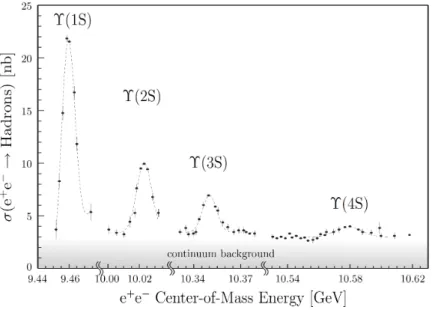

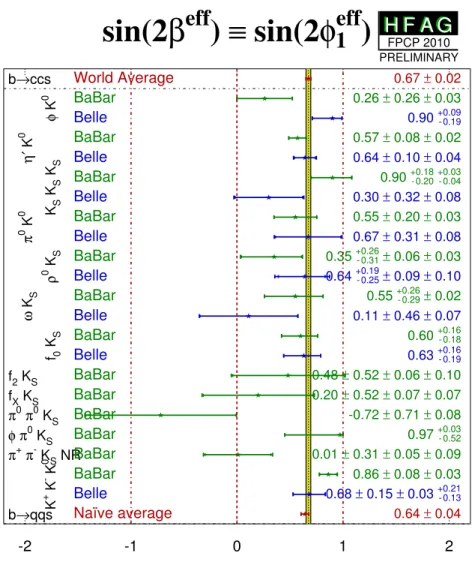
![Figure 3.1: The integrated luminosity recorded by Belle [29].](https://thumb-eu.123doks.com/thumbv2/1library_info/4024954.1542038/36.892.116.807.185.644/figure-integrated-luminosity-recorded-belle.webp)
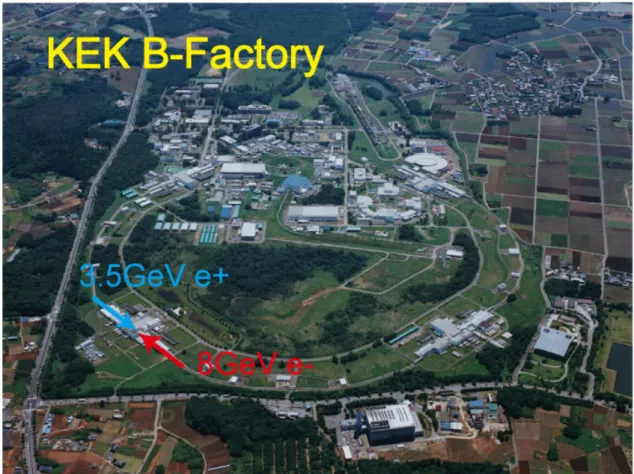
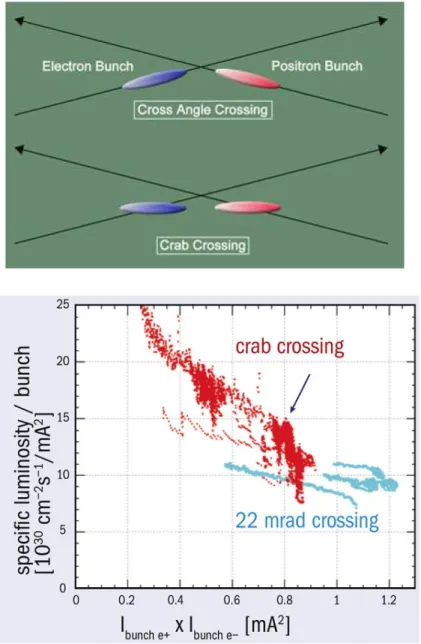
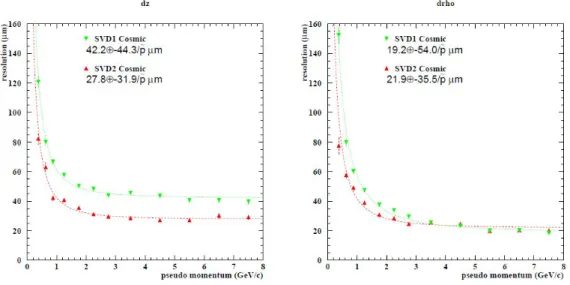
![Figure 3.8: The structure of the CDC. All units are in mm [31].](https://thumb-eu.123doks.com/thumbv2/1library_info/4024954.1542038/43.892.189.735.192.493/figure-structure-cdc-units-mm.webp)
![Figure 3.9: CDC dE/dx vs. momentum of collision data [31].](https://thumb-eu.123doks.com/thumbv2/1library_info/4024954.1542038/44.892.255.653.208.593/figure-cdc-de-dx-vs-momentum-collision-data.webp)